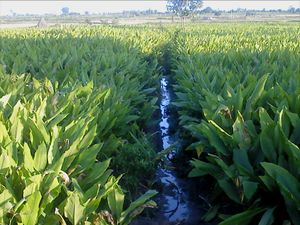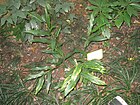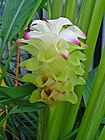Note: This is a project under development. The articles on this wiki are just being initiated and broadly incomplete. You can Help creating new pages.
Difference between revisions of "Curcuma longa - Haridra"
Chaithrika (talk | contribs) |
(→References) |
||
| (25 intermediate revisions by 3 users not shown) | |||
| Line 1: | Line 1: | ||
[[File:Turmeric.JPG|thumb|right|''Turmeric'', ''Haladi'', ''Curcuma longa'']] | [[File:Turmeric.JPG|thumb|right|''Turmeric'', ''Haladi'', ''Curcuma longa'']] | ||
| + | '''Turmeric''' is a rhizomatous herbaceous perennial plant of the ginger family Zingiberaceae. It is native to southern Asia, requiring temperatures between 20 and 30 °C and a considerable amount of annual rainfall to thrive. | ||
| + | ==Uses== | ||
| + | {{Uses|Psoriasis}}, {{Uses|Warts}}, {{Uses|Alzheimer’s disease}}, {{Uses|Parkinson’s disease}}, {{Uses|Ulcerative colitis}}, {{Uses|Arthritis}}. | ||
| − | + | ==Parts Used== | |
| + | {{Parts Used|Rizhomes}}. | ||
| − | + | ==Chemical Composition== | |
| + | The rhizomes contain curcuminoids, curcumin, cyclocurcumin, bisdemethoxycurcumin<ref name="chemical composition"/> | ||
| − | == | + | ==Common names== |
| + | {{Common names|kn=Arishina, Arisina|ml=Manjal|sa=Haridra|ta=Manjal|te=Haridra|hi=Haldi|en=Turmeric}} | ||
| − | + | ==Properties== | |
| + | Reference: Dravya - Substance, Rasa - Taste, Guna - Qualities, Veerya - Potency, Vipaka - Post-digesion effect, Karma - Pharmacological activity, Prabhava - Therepeutics. | ||
| + | ===Dravya=== | ||
| − | + | ===Rasa=== | |
| + | Tikta (Bitter), Kashaya (Astringent) | ||
| + | ===Guna=== | ||
| + | Laghu (Light), Ruksha (Dry) | ||
| + | ===Veerya=== | ||
| + | Ushna (Hot) | ||
| + | ===Vipaka=== | ||
| + | Katu (Pungent) | ||
| + | ===Karma=== | ||
| + | Kapha, Vata | ||
| + | ===Prabhava=== | ||
| − | + | ==Habit== | |
| + | {{Habit|Herb}} | ||
| − | The | + | ==Identification== |
| + | ===Leaf=== | ||
| + | {{Leaf|Simple|Alternate|The leaves are divided into 3-6 toothed leaflets, with smaller leaflets in between}}<ref name="Leaf"/> | ||
| + | |||
| + | ===Flower=== | ||
| + | {{Flower|Unisexual|2-4cm long|Yellow, pink or orange|5|Flowering may occur early in the growing season}} | ||
| + | |||
| + | ===Fruit=== | ||
| + | {{Fruit|Simple|7–10 mm|Fruiting time is June and July||many}} | ||
| + | |||
| + | ===Other features=== | ||
| + | |||
| + | ==List of Ayurvedic medicine in which the herb is used== | ||
| + | * [[Haridra khanda]] | ||
| + | * [[Khadiradi vati]] | ||
| + | * [[Nisa Kathakadi kashayam]] | ||
| + | * [[Nishamalakai churna]] | ||
| + | <ref name="Ayurvedic preparations"/> | ||
| + | |||
| + | ==Where to get the saplings== | ||
| + | ==Mode of Propagation== | ||
| + | {{Propagation|Seeds}}. | ||
| + | |||
| + | ==How to plant/cultivate== | ||
| + | While preparing the nursery for turmeric production, at the same time we cultivate a green manure crop (Daincha) inthe main field<ref name="How to plant/cultivate"/> | ||
| + | |||
| + | ==Commonly seen growing in areas== | ||
| + | {{Commonly seen|Tropical area}}, {{Commonly seen|Southeast asia}}, {{Commonly seen|Southern australia}}. | ||
| + | |||
| + | ==Photo Gallery== | ||
| + | <gallery class="left" caption="" widths="140px" heights="140px"> | ||
| + | Curcuma domestica.jpg | ||
| + | |||
| + | Curcuma longa (Haldi) Im IMG 2441.jpg | ||
| + | |||
| + | |||
| + | Curcuma longa (Haldi) W IMG 2440.jpg | ||
| + | |||
| + | |||
| + | Curcuma longa (Haldi) W2 IMG 2440.jpg | ||
| + | |||
| + | |||
| + | Curcuma longa (leaves).png | ||
| + | |||
| + | |||
| + | Curcuma longa - Hong Kong Botanical Garden - IMG 9629.JPG | ||
| − | |||
| − | <references> | + | Curcuma longa 001.JPG |
| − | <ref name=" | + | |
| − | + | ||
| + | Curcuma longa 2zz.jpg | ||
| + | |||
| + | |||
| + | Curcuma longa DSCN0555.jpg | ||
| + | |||
| + | </gallery> | ||
| + | |||
| + | ==References== | ||
| + | |||
| + | <references> | ||
| + | <ref name="chemical composition">[http://www.thepharmajournal.com/vol4Issue1/Issue_Mar_2015/4-1-18.1.pdf Chemical constituents]</ref> | ||
| − | == | + | <ref name="Leaf">[https://www.plantdelights.com/blogs/articles/curcuma-longa-turmeric-plant-zedoaria-ginger Curcuma Morphology]</ref> |
| + | <ref name="Ayurvedic preparations">[https://easyayurveda.com/2013/10/23/turmeric-curcuma-longa-benefits-usage-dose-side-effects/ Ayurvedic preparations]</ref> | ||
| − | + | <ref name="How to plant/cultivate">[http://practicalplants.org/wiki/Agrimonia_eupatoria Cultivation]</ref> | |
| + | </references> | ||
| + | ==External Links== | ||
| + | * [http://www.curcuminforhealth.com/growing-harvesting-and-manufacturing/ Growing, Harvesting, and Manufacturing Curcumin] | ||
| + | * [https://www.herbal-supplement-resource.com/turmeric-benefits.html Turmeric Uses and Benefits as a Medicinal Herb] | ||
| + | * [https://en.mr-ginseng.com/turmeric/ Curcuma longa on ginsneg.com] | ||
[[Category:Herbs]] | [[Category:Herbs]] | ||
| + | [[Category:Zingiberaceae]] | ||
Latest revision as of 12:32, 21 April 2020
Turmeric is a rhizomatous herbaceous perennial plant of the ginger family Zingiberaceae. It is native to southern Asia, requiring temperatures between 20 and 30 °C and a considerable amount of annual rainfall to thrive.
Contents
- 1 Uses
- 2 Parts Used
- 3 Chemical Composition
- 4 Common names
- 5 Properties
- 6 Habit
- 7 Identification
- 8 List of Ayurvedic medicine in which the herb is used
- 9 Where to get the saplings
- 10 Mode of Propagation
- 11 How to plant/cultivate
- 12 Commonly seen growing in areas
- 13 Photo Gallery
- 14 References
- 15 External Links
Uses
Psoriasis, Warts, Alzheimer’s disease, Parkinson’s disease, Ulcerative colitis, Arthritis.
Parts Used
Chemical Composition
The rhizomes contain curcuminoids, curcumin, cyclocurcumin, bisdemethoxycurcumin[1]
Common names
| Language | Common name |
|---|---|
| Kannada | Arishina, Arisina |
| Hindi | Haldi |
| Malayalam | Manjal |
| Tamil | Manjal |
| Telugu | Haridra |
| Marathi | NA |
| Gujarathi | NA |
| Punjabi | NA |
| Kashmiri | NA |
| Sanskrit | Haridra |
| English | Turmeric |
Properties
Reference: Dravya - Substance, Rasa - Taste, Guna - Qualities, Veerya - Potency, Vipaka - Post-digesion effect, Karma - Pharmacological activity, Prabhava - Therepeutics.
Dravya
Rasa
Tikta (Bitter), Kashaya (Astringent)
Guna
Laghu (Light), Ruksha (Dry)
Veerya
Ushna (Hot)
Vipaka
Katu (Pungent)
Karma
Kapha, Vata
Prabhava
Habit
Identification
Leaf
| Kind | Shape | Feature |
|---|---|---|
| Simple | Alternate | The leaves are divided into 3-6 toothed leaflets, with smaller leaflets in between |
Flower
| Type | Size | Color and composition | Stamen | More information |
|---|---|---|---|---|
| Unisexual | 2-4cm long | Yellow, pink or orange | 5 | Flowering may occur early in the growing season |
Fruit
| Type | Size | Mass | Appearance | Seeds | More information |
|---|---|---|---|---|---|
| Simple | 7–10 mm | Fruiting time is June and July | many | {{{6}}} |
Other features
List of Ayurvedic medicine in which the herb is used
Where to get the saplings
Mode of Propagation
How to plant/cultivate
While preparing the nursery for turmeric production, at the same time we cultivate a green manure crop (Daincha) inthe main field[4]
Commonly seen growing in areas
Tropical area, Southeast asia, Southern australia.
Photo Gallery
References
External Links
- Ayurvedic Herbs known to be helpful to treat Psoriasis
- Ayurvedic Herbs known to be helpful to treat Warts
- Ayurvedic Herbs known to be helpful to treat Alzheimer’s disease
- Ayurvedic Herbs known to be helpful to treat Parkinson’s disease
- Ayurvedic Herbs known to be helpful to treat Ulcerative colitis
- Ayurvedic Herbs known to be helpful to treat Arthritis
- Herbs with Rizhomes used in medicine
- Herbs with common name in Kannada
- Herbs with common name in Hindi
- Herbs with common name in Malayalam
- Herbs with common name in Tamil
- Herbs with common name in Telugu
- Herbs with common name in Sanskrit
- Herbs with common name in English
- Habit - Herb
- Index of Plants which can be propagated by Seeds
- Herbs that are commonly seen in the region of Tropical area
- Herbs that are commonly seen in the region of Southeast asia
- Herbs that are commonly seen in the region of Southern australia
- Herbs
- Zingiberaceae









